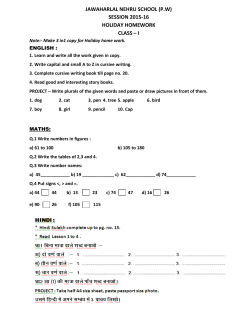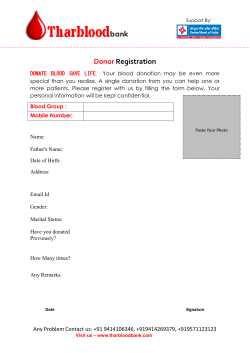
Pastepaper Mosaic - Dick Blick Art Materials
Copyright © 2015 Dick Blick Art Materials All rights reserved 800-447-8192 DickBlick.com Pastepaper Mosaic Use a fun, traditional bookmaking technique to make pastepaper, then cut and tear pieces to make a modern mosaic! (art + history) A visit to an antique or rare bookstore might unveil beautifully decorated endpapers in books that were published in Europe between the late 16th and 18th centuries. Earlier books had no endpapers — they were unavailable to the common man and became prized possessions of churches and monasteries. After the printing press was invented, however, it was soon obvious that endpapers were needed to protect the text inside the book from wear and tear. At that time, book covers were often just heavy hides stretched over wooden boards. There were many methods used to decorate endpapers, including marbling, stamping, or printing designs. But pastepaper is special. No one has been credited with inventing pastepaper. It’s likely that it began in bookbinderies where all the necessary ingredients were readily available: paper, paste, pigments, and tools to make designs with. The techniques for creating pastepaper are simple and have changed very little over the centuries. Pastepaper always starts with some type of paste, usually cooked with some kind of flour. Many other ingredients can be added such as vinegar, soap, or glycerin, but the recipe is just the preference of the artist. Pigments are then added to the paste and tools are pressed into or drawn through the wet paste to create beautiful and intricate patterns. Some traditional tools included brushes, combs, carved wooden rolling pins, or even the artist’s thumb, palm, or side of the hand — which may explain why pastepaper is sometimes linked to fingerpainting. Using a premade rice paste powder tinted with acrylic paint, pastepaper masterpieces are easy and quick to make. After assembling many sheets in the classroom, the papers are torn to create mosaic “tiles,” then reassembled into an intricate, patterned mosaic. Materials (required) Amaco Rice Paste Powder, 8 oz jar (34125-1008); need one per class to make six pints of paste Blick Studio Acrylics, 8 oz (01637-); share at least five colors across class Canson Mi-Teintes Drawing Papers, package of 25, 8-1/2” x 11” (10710-); need at least three packages of different colored papers Combs, Graduated Two-Sided Rubber Comb (056481020); share five across class Liquitex Pouring Medium, 8 oz (020011002); need two Blick Economy Golden Taklon Flat, Size 8 (05168-1008); one per student upon a class size of 24 students. Adjust as needed. Golden Nylon Paste Brush (24902-4058); share at least five across class Preparation Optional Materials 1. Princeton Catalyst Wedges and Contours (03422-) GRADES 3-12 Note: Instructions and materials are based Mix Amaco Rice Paste Powder into six separate batches (each will be one pint). 2. Cover tables and assemble large brushes and various combs and tools. Princeton Catalyst Blades and Mini-Blades (06421-) 1. Process 1. Color each batch of rice paste by adding acrylic paint until it is the desired color. Metallics or other specialty paints can be used. 2. Supply each student with two or three of the colored Mi-Teintes drawing papers. Using a wide brush, brush an even coat of rice paste over the surface of the paper. The more contrast between the paste and the paper, the more evident the pattern will be. Now, use combs and tools to comb through the paste, working from left to right. Wiggle the combs, or rotate them in a circular pattern. Overlap a wave pattern using another tool. If a pattern doesn’t work out, reapply a coat of paste and try again. Slightly dampening the back of the paper with a sponge will help keep the paper from curling during the process. Allow the papers to dry completely. 3. Now, tear or cut the papers into pieces and keep them in colored batches. After drawing the outline of a portrait or other scene onto one of the colored papers, fill in each separate area with pastepaper pieces using glue. Brush glue into one area at a time, and apply the pieces, leaving 1/4” or smaller gap between the edges. Allow to dry. Step 1: Pull combs through pigmented paste to create a pattern on the paper. 4. Once the entire composition is filled in with mosaic pastepaper pieces, brush on a coat of Liquitex pouring medium. The medium will flow to the “grout” lines between the paper pieces and add a final gloss to the composition. National Core Arts Standards - Visual Arts Connecting Anchor Standard 11: Relate artistic ideas and works with societal, cultural, and historical context to deepen understanding. Step 2: Tear or cut colored pastepapers into small mosaic-sized pieces. Step 3: Glue pieces onto a sketch to create a mosaic look. Step 4: Brush on Liquitex Pouring Medium to mimic the look of a glossy glaze. 800-447-8192 DickBlick.com 2.
© Copyright 2025









